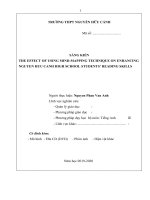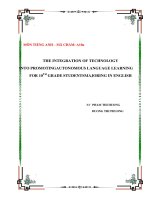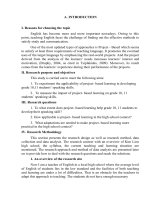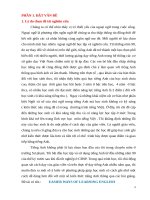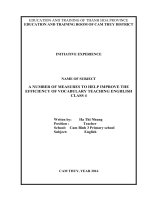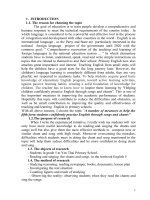(Sáng kiến kinh nghiệm) a number of my experience that heps students learn english deeply and effectively in nghi son secondary and high school
Bạn đang xem bản rút gọn của tài liệu. Xem và tải ngay bản đầy đủ của tài liệu tại đây (484.12 KB, 15 trang )
CONTENTS
I.INTRODUCTION…………………………………………… Page 2
1. The reason for choosing the issue…………………………… Page 2
2. The aims of studying the issue……………………………… Page 2
3. The subjects of studying the issue…………………………… Page 2
4. The studying methods ……………………………………
Page 2, 3
II. CONTENTS OF STUDYING THE ISSUE……………… Page 3
1. Theory base of the issue……………………………………Page 3
1.1. Three basic stages of learning a language by babies …Page 3,4
1.2. Seven rules of learning English effectively
by Effortless English ………………………………….Page 4
2. The fact of issue before carrying out the studying. ………Page 4
3. The solutions applying for the above facts……………… Page 4
3.1. Applying the technique No.1: Repetition…………… Page 5,6,7
3.2. Applying the technique No.2:
Learning words in sentences…………….....................Page7,8
3.3. Applying the technique the technique No.3:
Listen and answer drills………………………………...Page 8,9,10,11
3.4. Applying the technique the technique No.4: Miming .Page 11,12, 13
III. CONCLUSIONS AND PROPOSALS………………… Page 13
1. Conclusions. …………………………………………… Page 13
2. Proposals…………………………………………………Page 13
1
I.
INTRODUCTION.
1. The reasons for choosing the issue
For many English learners at school, they usually find it difficult to remember
what they have been taught by their teachers. A lot of new words, new structures,
new grammar rules, long reading lessons….
All of these above factors make
students feel bored with their lessons and after a long time learning English, they
forget almost of them. As a result, they cannot get good marks at school on this
subject. And the most important thing, they cannot use English in real life.
I have been teaching English for more than ten years, I always try to find the
best way to help students deeply remember what they have learnt and more
important, they can use English in real situations. And I have applied a number of
techniques I think that will be very effective in teaching and learning English.
That’s way I choose this topic to study and apply in my teaching job at my present
school.
“A NUMBER OF MY EXPERIENCE THAT
HELPS STUDENTS LEARN ENGLISH DEEPLY AND EFFECTIVELY IN
NGHI SON SECONDARY & HIGH SCHOOL”
2. The aims of studying the issue.
I study this issue in hope of finding the most effective ways to help students
remember what they have learned permanently because only by memorizing the
language permanently can they use it in doing their exercises, the text and the most
important things, they can apply it in the real life.
3. The subjects of studying the issue
This issue is on the subjects of how to memorize the English language in the
most natural way like the way a child learn to speak their mother tongue.
4. The studying methods
To carrying out this work, I use the following methods:
2
4.1.
The method of studying and building up theory bases which is proved by
language researchers.
4.2.
The method of doing survey, collecting information
4.3.
The method of data counting and statistics.
II. CONTENTS OF STUDYING THE ISSUE
1. Theory base of the issue.
According to the language researchers, to learn any language effectively, not
only English, language learners must know how to learn it in the most natural way.
That is the ways babies and small children learn how to speak their mother
language.
As a teacher of English, I always try to follow the rules of learning a language in
the most natural ways. I have studied a lot of documents about how babies learn
their mother tongue. Besides, I find that the 7 rules of learning English effectively
by Effortless English is also very useful to a teach students to learn English
effective.
I.1.
Three basic stages of learning a language by babies [1]
Babies are born with the ability to learn it and that learning begins at birth. All
children, no matter what language their parents speak, learn a language much the
same way. This learning takes place in three basic stages
Stage One – Learning Sounds: When babies are born, they can make and hear all
the sounds in all the languages in the world.
Stage Two – Learning Words
At this stage children essentially learn how the sounds in a language go together to
make meaning. These are called “word boundaries.”
Stage Three – Learning Sentences
During this stage, children learn how to create sentences. That means they can put
words in the correct order.
I.2.
Seven rules of learning English effectively by Effortless English [2]
3
1. Study Phrases, Not Individual Words
2. Do not focus on Grammar
3. The Most Important Rule– Listen First
4. Slow, Deep English Learning Is Best
5. Use Point Of View Mini-Stories
6. Only Use Real English Lessons & Materials
7. Listen and Answer, not Listen and Repeat
2. The fact of issue before carrying out the studying.
Many English learners in secondary school cannot remember much of what
they have learnt after many years of learning English. Every day, the teacher teaches
them a lot of new words but they forget many of them or they cannot use those new
words in real situations. It’s because of the fact that the teacher does not know how
to teach them in the ways that not only help them remember it deeply and naturally
but also cheer them up in the language class. I have always tried to deal with these
problems.
3. The solutions applying for the above facts
I recognized that the most useful way to memorize the language is make them
learn it in the most natural way which is like the way a child learns to speak his
mother language. This is also clearly proved by the language researchers.
Within the present teaching facilities in my school and the given English program of
for Grade 6,7,8,9 , I have tried to apply the following techniques and I found that I
have got a number of certain good results during the school year 2016-2017.
I have applied the following technique
Technique No.1: Repetition
Technique No.2: Learning words in sentences
Technique No.3: Ask and answer drills
Technique No.4: Miming
Here are the way I have applied the above techniques in teaching English to the
students of grade 6,7,8,9 in details
4
3.1. Applying the technique No.1: Repetition
While teaching English to my students, I always tell them that “repetition” is
one rule of memorizing any information. The more the information is repeated in
our mind, the longer we can memorize it. If learners want to memorize the language
permanently, they must learn them deeply by. So I always encourage my student to
repeat what they have learned as much as possible. This is how I ask them to learn
the language deeply this way
3.1.1.Repeating words and sentences at home by writing
I ask each of my students to have a “Word and sentence learning note
book” After each lesson in class, students have to practice writing each new word or
new structure five or ten times at home.
Here are the copy from one notebook of one of my student in grade 6 in the
school year 20016- 2017 for Unit 4- Lesson C- Getting ready for school.(Page 49Student Book- Old English Program for Secondary school)
After studying this lesson at school, at home students not only have to do
homework but also practice writing ten times for each new word and sentences
using those words.
5
3.1.2.Repeating the main content of the old lesson in the next class time.
At the end of each lesson, I always ask students, especially the students of
grade 8 or 9, to try to summarize the main content of the lesson, revise it carefully at
home and then repeat it at the beginning of the next lesson. This not only helps
students to memorize the new words deeply, how to use the new words in real
contexts but also exercise their brain in English.
For example, in English 8, Unit 9: A FIRST
-
AID
COURSE,
After
studying the first lesson: Getting started, at the end of the lesson, I ask students to
summarize the main content of the lesson. After helping students correcting some
mistakes, we have a summary on the board:
“A student named Lan makes a phone call to Bach Mai hospital for an
ambulance because there is an accident in Quang Trung school. A student fell of
her bike and hit her head on the road. She had a bad cut on her hand and it’s
bleeding quite badly. The nurse tells Lan to use a towel or a handkerchief to cover
the wound, put pressure on it and hold it tight in order to stop bleeding. The nurse
6
asks for address the tells Lan that the ambulance will be there in 10 minutes. She
also reminds Lan to keep the injured person awake”.
I require students to revise this summary at home and in the next class time, I
call some students to present this content in class. As far as I am concerned, this is
an useful way for learners to learn the lesson deeply.
3.2.
Applying the technique No.2: Learning words in sentences
3.2.1. Learners practice writing not only words but also sentences at home
(The same as what I have presented in part 3.1.1)
3.2.2. Learners practice using new words while learning them in class with
pictures, real objects or given situations
Within only forty- five minutes for each class lesson, I always try to give students
more chance to practice new words in sentences with pictures, real objects or given
situation. Here are some examples
Example 1: Practicing new words in sentences with pictures- English 6- Unit 9Lesson B: Face
Because the Text book is sometimes boring to students, I often collect a lot of
pictures from the Internet that relate to the topic of the lessons. The pictures are
often about famous person or funny characters on popular movies or cartoons. This
makes my students more exciting attention to the lesson. In the Production stage of
this lesson, I use a picture about a very popular character called Mr. Bean, the main
character in the same famous funny movie.
7
In the Production stage, students know how to describe a person’s face, using the
vocabulary of parts of the face such as: hair, eyes, nose, mouth, lips, teeth………
I give my students a number of questions such as:
- Do you know who this man is? (He is Mr. Bean)
- What do you know about him? (He is very funny, kind but sometime quite
crazy, sometimes stupid…)
Then I ask my students a lot of question about Mr. Bean’s appearance such as,
- What color is his hair?
- Are his eyes big or small? What color are they?
- Is his face round or oval?
- Does he have big white teeth?
- Does he have full or thin lips?
Finally, I ask my students to describe Mr. Bean in a short passage. Some of them
will present their speaking in front of the whole class.
Suggested answer: “This is Mr. Bean. He has short black hair. He has a round face
and big brown eyes. He has full lips…."
3.3.
Applying technique No.3: Listen and answer drills.
When I was a student, my teacher used to ask her students to listen and repeat the
new words, the new sentences or the conversations in the text book. However, if
learners listen and read all the time, they cannot memorize the words and sentences
deeply. Instead of asking student to listen and read all the time, I ask them to ask
and answer as much as possible. My students have chances to listen and answer
while they are being introduced new vocabulary, while they are learning new
structures, while they are practicing the conversations, while they are doing
grammar exercises and so on…. Listen and answer drill in class helps learners to
exercise their brain in English.
Here are some examples about how I apply Listen and answer drill in class.
Example 1: English 6- Unit 12- Lesson A 1,2,3 (Page 124- Student book)
Practicing listen and answer drill while learning presentation text
8
In this lesson, students practice asking and answering about what people are doing
at the moment.
In the Presentation stage, while presenting the new language, instead of asking
students to listen and repeat the text, I just play the tape twice so they can copy the
way the speaker speaks, then I show the pictures and give students the questions and
ask them to answer.
T: What’s he doing?
Ss: He’s swimming
T: What’s she doing?
Ss: She is skipping
T: What are they doing?
Ss: They are playing tennis
T: What are they doing?
Ss: They are playing badminton
T: What are they doing?
Ss: They are playing soccer
T: What are they doing?
Ss: They are playing volleyball
T: What’s he doing?
Ss: He is jogging
T: What’s she doing?
Ss: She is doing aerobics
T: What are they doing?
Ss: They’re playing table tennis
Example 2: English 9- Unit 1: A visit from a pen pal- Getting started- Listen and
read.- Practice listen and answer drills while learning new words.
In this lesson, students learn the words: correspond, be impressed by, mausoleum,
mosque, atmosphere, pray, depend on
To help my student remember these words deeply, while introducing the new words,
I give students a lot questions so that students have more chance to practice new
vocabulary in sentences as well as exercise their brain in English.
9
For instant, while introducing the words “correspond”
- Do you have a pen pal?
- Do you and your pen pal usually correspond?
- How often do you correspond?
- Do people usually correspond through surface mail nowadays?
- How do people usually correspond now a day? (Suggested answer: through
email)
While introducing the word “pray”, I give students several questions such as:
- Tell me the place where people usually come to pray? (suggested answers:
church, pagoda, cemetery…)
- In which event do people usually pray? (suggested answers: in the new
year’s Eve, in the traditional festivals…)
Example 4: English 9: Unit 6- The environment- Language focus (Page 56)
Helping students learn words deeply while doing grammar exercises with
“Question and answer drill”
At secondary schools, students have to do a lot of grammar exercises to prepare for
their regular written tests of or final test or entrance exam in to High school.
Sometimes I recognized that students feel tired with these boring exercises. So I try
to warm them up by giving some more questions which also help them practice
using the language in a more active way.
In exercise 5 Page 56, students do a grammar exercises relating to the topic of the
environment. Therefore, to help them get way from boredom with this activity, I
give them some more questions relating to the sentences they have just finish.
After they finish the sentences, I give students some more easy questions, so that
they can answer it easily and quickly.
Sentence a) “If the rice paddies are polluted, rice plants will die”,
-Teacher questions: “What will happen if rice plants die?”
-Students’ suggested answer: “If rice plants die, we won’t have food to eat”
-Teacher’ “What will happen if we don’t have food to eat”
10
-Students’ suggested answer: “If we don’t have food to eat, we will die”
Sentence b) “If we go on littering, the environment will become seriously polluted”
-Teacher’s question: “What will happen if the environment becomes seriously
polluted?”
-Students’ suggested answer: “If the environment becomes seriously polluted,
people will die”
-Teacher’s question: “What should we do to stop this bad thing?”
-Students’ suggested answer: “We should stop littering”
…………………………………
With these questions, my students not only can have more chance to practice
talking about the topic the environment but also feel more interested in the lesson.
3.4.
Applying the technique: Miming/ Acting
As we know, while learning a language, if learners want to memorize words deeply,
besides learning it with eyes, ears and mouth, they should also combine them with
feelings and gestures or body language. That’s why I always try to use up and
chances in which my students can express the language in their face expressions,
gestures or body language. It’s very useful way for learner to remember the
language quickly and deeply. Here are some of my examples in which I ask my
students to express the meaning of words or sentences in face expressions or
miming.
Example 1: English 6- Unit 10: Staying healthy- Lesson A: How How do you
feel? (Page 104)
After the lesson, Students can talk about one’s feeling and what they want in each
situation, using the words: feel, hungry, tired, full, thirsty, would like, a cold
drink…….
In the production stage, I ask some volunteers to act some situations of different
feelings. They must express their feelings with their face expressions and their body
languages. ?The other students will guess how they feel and what they would like.
Suggested activities in class:
11
- Volunteer 1 acts as if she were hungry, other students say: “She is hungry.
She would like some noodle?
- Volunteer 2 acts as if he were hot, other students say: “ He’s hot. He would
like a cold drink
- …………
Example 2: English 6- Unit 13- Lesson B: Activities in seasons. (Page 138Student Book)
In the presentation stage, to help students revise the vocabulary about free time
activities, I call some volunteer to stand in front of the whole class. They do not say
anything, just express the activities through their body languages. The rest of the
class with guess that student often do in free time.
For example,
-Volunteer 1 acts as if he were swimming in the river, other students will say in
chorus: He/ She often goes swimming in his free time
-Volunteer 2 acts as if he were sailing in the lake, other students will say in chorus:
She/ he often goes sailing in the summer
………………
4.
The effectiveness of applying the above solutions.
Though a year of applying the above teaching techniques, I find out that I have
got the following optimistic results.
4.2.
Many students feel more and more excited about this subject, even in the
lesson in which students mainly do boring grammar exercises.
4.3.
Students become more interested in English lessons. They find this subject is
easier and more interesting to learn.
4.4.
Many students remember words and structures well and they can do very well
in their regular tests or final exams.
12
4.5.
The most important thing, some of my students can build up their speaking
skill, they can express their ideas in English more automatically and fluently
than the students of the previous school year.
III. CONCLUSIONS AND PROPOSALS.
3. Conclusions.
After year of teaching and self- studying to build up teaching ability, I find
that the most useful way to teach a language to learners is teaching them in the most
natural way. As far as I am concerned, the above experiences contribute a lot in
gradually improving the result of teaching and learning English in my school.
Sharing these experience ideas, I hope to receive comments and adjustment from
other colleagues in order to build up my teaching ability.
2. Proposals.
By the way, I would like to send my proposals to the leaders of the
Department of Education and Training. I would like to say that the excellent
experienced ideas which were recognized by The Departure of Education and
Training should be widely popularized so that we can learn more from other
colleagues’ experiences in order build up our teaching ability.
************ The end***************
13
REFERENCE MATERIALS
*****************
Sources from the Internet
[1] />
[2]
/>
rules-to-learn-english-40.html)
14
Xác nhận của thủ trưởng đơn vị.
Thanh hóa, ngày 22/ 4/ năm 2013.
Tơi xin cam đoan đây là SKKN
của mình viết, không sao chép nội
dung của người khác
Người thực hiện:
Lê Thị Định.
15



